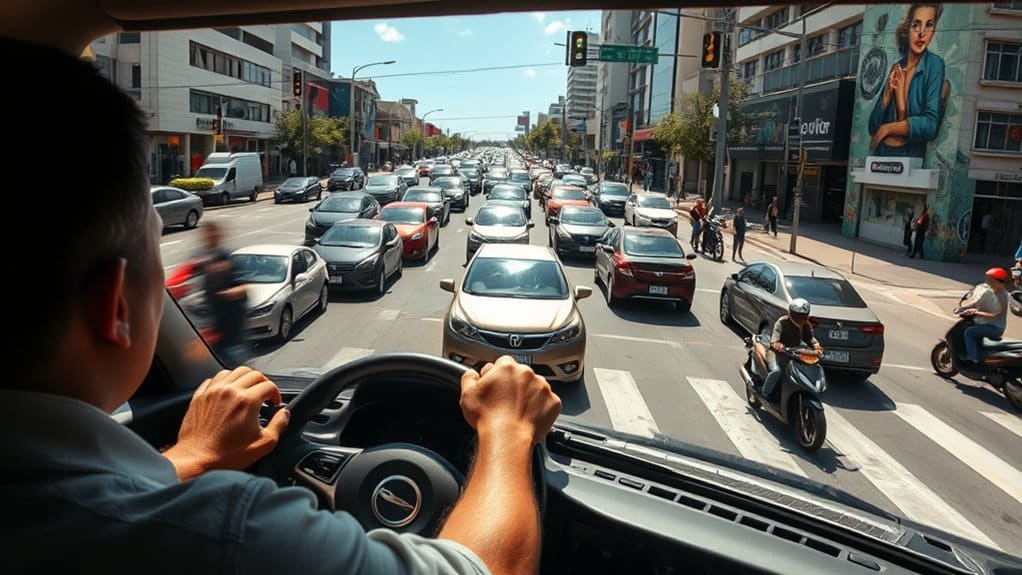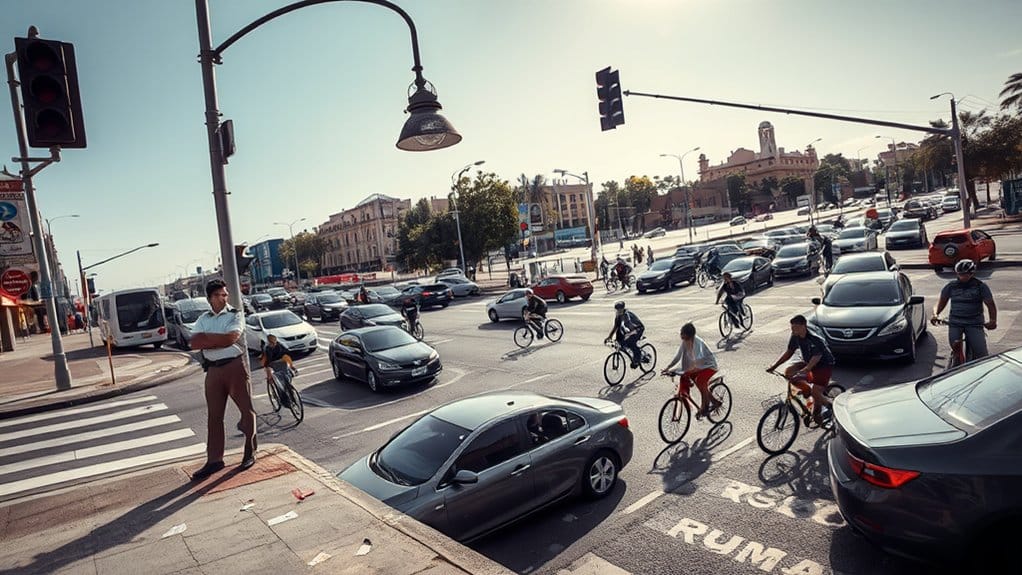Drivers in Uruguay often disregard traffic rules, reflecting a deeper issue of complacency and lack of recognition, prompting an essential examination of the factors contributing to this ignorance, and the urgent need for effective solutions.
Key Takeaways
- Lack of driver education contributes to ignorance.
- Inconsistent law enforcement exacerbates the issue.
- Poor road conditions complicate rule adherence.
- Culture of complacency prevails among drivers.
- Insufficient public awareness of traffic rules exists.
Understanding Traffic Laws

Drivers in Uruguay must maneuver a complicated web of traffic laws, which, unfortunately, are often disregarded, leading to a substantial number of accidents and fatalities on the country’s roads. Traffic law clarity, enforcement effectiveness are essential, yet often lacking, resulting in chaos, and a need for stricter regulations, to protect citizens, and enhance freedom of movement, through safe, and responsible driving practices, ultimately reducing accidents, and fatalities, and ensuring a safer, more emancipated experience. The implementation of speed limits has been instrumental in attempting to control the traffic situation, but more needs to be done to address the root causes of the problem.
Driver Behavior Analysis
Driver behavior in Uruguay is influenced by various factors, including road habits, safety consciousness, and the prevalence of driver errors, which contribute to a complicated terrain of traffic safety. The analysis of these factors reveals a need for increased enforcement and education, as compliance with traffic rules, such as speed limits and seat belt usage, varies widely, and distractions, like mobile phone use, remain a significant concern. By examining the intersections of driver errors, road habits, and safety consciousness, it becomes clear that a multi-faceted approach is necessary to address the root causes of unsafe driving practices and foster a culture of responsible driving in Uruguay. The country’s high rate of road crashes, resulting in 457 deaths in 2004, underscores the importance of educating drivers about the consequences of reckless behavior and the need for stricter traffic regulations to reduce the number of accidents.
Driver Errors
As road traffic injuries continue to claim lives, particularly among young individuals and children, it becomes clear that a thorough analysis of driver behavior is essential. Driver errors, including distracted driving, and flawed risk perception, contribute to accidents. Low seat belt use, impaired driving, and lack of safety equipment exacerbate the issue, highlighting a need for improved driver consciousness and compliance with traffic rules to mitigate tragedies and ensure freedom of movement on Uruguayan roads. The increase in traffic fatalities after cannabis legalization, with a notable 52.4% increase in light motor vehicle drivers fatality rate, suggests that drivers are not adequately aware of the risks associated with driving under the influence of cannabis.
Road Habits
While the consequences of road traffic accidents continue to mount, particularly among vulnerable populations, it becomes increasingly evident that analyzing road habits is vital for mitigating these tragedies, because the persistent lack of compliance with traffic rules, combined with flawed risk perception, contributes significantly to the alarming rates of injuries and fatalities. Improved seat belt consciousness and helmet regulations are essential, as low seat belt use and inconsistent helmet usage exacerbate risks, highlighting the need for stronger enforcement and education to encourage safer road habits. The overall decline in traffic accident deaths, including a rate of 14.80 deaths per 100,000 people in 2019, underscores the importance of continued efforts to improve road safety through education and enforcement.
Safety Awareness
Numerous factors contribute to the alarming rates of road accidents in Uruguay, and notably, many of these incidents can be attributed to a lack of safety awareness among road users, particularly drivers. Safety perceptions must shift through awareness campaigns, modifying driver behavior, and promoting a culture of responsibility, ultimately reducing accidents and fatalities, thus, enhancing road safety, and fostering a community that values freedom, and responsible driving habits. The integration of Formal driver education programs into licensing systems can help address this issue by teaching safe driving practices and promoting a culture of road safety.
Road Safety Statistics Review
Several key statistics highlight the severity of road safety issues in Uruguay, where nearly 1.3% of the population, over 43,000 individuals, were victims of non-fatal injuries due to road crashes in 2004, corresponding to a staggering annual injury rate of 13.8 deaths per 100,000 individuals. Key concerns include:
- High injury rates
- Low road safety initiatives
- Inadequate injury prevention strategies, all hindering freedom, and necessitating urgent reform. The total road length in Uruguay, which measures 77,732 kilometers, poses significant challenges for traffic management and road safety enforcement.
Compliance With Regulations

Road safety statistics in Uruguay highlight the need for improved compliance with regulations, as the alarming rates of injuries and fatalities demand a more rigorous approach to enforcement and observance of traffic rules. Regulatory compliance, public consciousness are essential, with measures like speed limits, safety equipment usage, and anti-distracted driving laws. Effective enforcement, coupled with public awareness campaigns, is necessary to encourage a culture of respect for traffic rules, ultimately reducing accidents and fatalities, and fostering a safer environment. The implementation of body-worn cameras has been shown to increase police legitimacy and can be a valuable tool in promoting compliance with traffic regulations.
The Role of Education
As the country grapples with the challenges of ensuring road safety, it becomes clear that education plays a significant role in shaping the driving culture in Uruguay, where a well-informed and responsible population is essential for reducing accidents and fatalities. Key issues include:
- Lack of driver education
- Educational gaps
- Inadequate training, highlighting the need for improved education to address these issues effectively. The driving schools in Uruguay should emphasize the importance of having a valid license, which can be obtained through a validation process that includes a medical examination and the presentation of an apostilled certificate of the foreign driver’s license.
Enforcement and Penalties

Most notably, effective enforcement of traffic rules in Uruguay has become an essential aspect of ensuring road safety, with authorities implementing various mechanisms to curb reckless driving habits, including speed cameras, semi-stationary enforcement systems, and radar control posts. Enforcement effectiveness and penalty transparency are critical, with clear fines and consequences for violations, promoting a culture of accountability and responsibility, ultimately enhancing road safety and protecting individual freedoms. The use of LiDAR technology in these systems has significantly improved the accuracy of speed measurements, allowing for more efficient enforcement and a reduction in accidents.
National Road Safety Strategies
National road safety strategies in Uruguay are focused on reducing accidents and promoting responsible driving practices, through initiatives such as road safety training and education, infrastructure planning, and multi-stakeholder approaches. The government, in collaboration with local and international organizations, has implemented various programs, including the “Road Safety Initiative for Cities” and the “Don’t Drink & Drive” campaign, to address critical issues like drunk driving and road infrastructure. By prioritizing road safety, traffic laws, and stringent enforcement, Uruguay aims to create a safer environment for drivers, pedestrians, and cyclists, ultimately reducing the number of accidents and fatalities on its roads. The country’s driving schools, such as those in Montevideo, offer intensive courses to help drivers acquire theoretical knowledge quickly and effectively.
Road Safety
Road safety in Uruguay is a pressing concern, necessitating a multifaceted approach, given that responsibility for it lies with various entities. Key strategies include:
- Road safety audits
- Implementation of intelligent transportation systems
- Community involvement for road safety improvement, promoting freedom and security. Effective community involvement is essential for road safety improvement, requiring a collaborative approach. The national assessment project aims to improve road safety by identifying high-risk locations and implementing safety measures, which is funded by the IDB.
Traffic Laws
Traffic laws in Uruguay are essential for ensuring safety on the country’s roads, given the alarming rate of accidents, and therefore, a strong emphasis is placed on strict enforcement, particularly with regards to speed limits, seatbelt usage, and drinking and driving. Effective traffic signalization and pedestrian rights are prioritized, promoting a safe environment, freedom of movement, and responsible driving practices, ultimately reducing accidents and fatalities on Uruguayan roads, with strict laws governing road use. The country also places importance on speed limits to prevent reckless driving and ensure road safety for all users.
Factors Contributing to Ignorance

A culture of complacency pervades the driving terrain in Uruguay, where a combination of factors contributes to a pervasive ignorance of traffic rules. Cultural attitudes, enforcement inconsistencies lead to recklessness. Key factors include:
- Lack of enforcement
- Poor road conditions
- Unwritten rules, contributing to a hazardous environment, where drivers freely disregard traffic laws, threatening freedom of movement. The frequent use of cellular phones while driving also poses a significant threat to road safety, highlighting the need for stricter enforcement and education on traffic regulations.




15 Responses
‘Poor road conditions’? That’s an understatement! It’s like driving through a minefield out there.
‘Safety awareness’ starts with each driver. If you don’t care about your life or others’, what’s the point?
‘Inconsistent law enforcement’ is a huge issue! If there were real consequences, maybe things would change.
Complacency? More like pure ignorance! People need to take driving seriously. It’s a privilege, not a right!
This article makes it seem like everyone is a bad driver. Not all of us ignore traffic laws!
‘Stricter regulations’ might help, but how do we get drivers to care enough to follow them?
‘Culture of complacency’? Sounds like an excuse. Drivers need to own up to their mistakes instead of blaming everything else!
‘Safety awareness’ seems like a buzzword. What real steps can be taken to improve this?
Education is key, but also enforcement! Why aren’t the police doing their jobs properly?
‘Poor road conditions’? Fixing roads won’t change reckless behavior behind the wheel. Drivers need better education first.
This article is just pointing fingers at drivers without offering real solutions! How about fixing the roads first?
I don’t understand why people can’t just follow the rules. It’s not that hard!
‘Culture of complacency’? Maybe people are just trying to adapt to their environment. It’s complicated!
‘Root causes’ are only part of the problem. People must stop using phones while driving; it’s common sense!
Isn’t it a bit dramatic to say it’s all about ‘complacency’? There are many factors at play here.